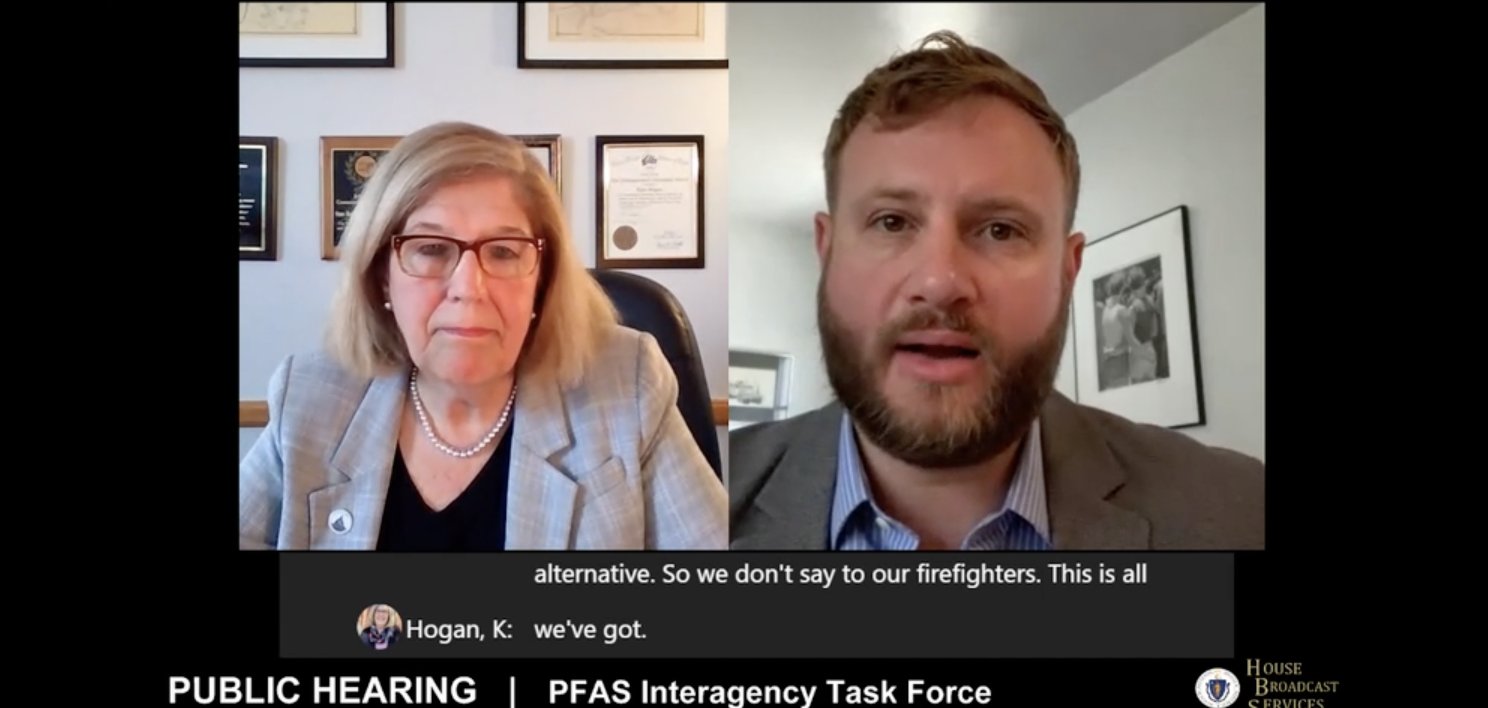latest
Massachusetts product bans among panel’s recommendations to rein in cancer-causing PFAS chemicals

By Colin A. Young
STATE HOUSE, BOSTON…..After almost a year of studying how “forever chemicals” touch nearly all aspects of life in Massachusetts, the PFAS Interagency Task Force released its final report Wednesday with recommendations that the state regulates PFAS chemicals as a class, restrict the sale of consumer products with intentionally-added PFAS, and work to raise public awareness of the ubiquity of the problem.
Per- and polyfluoroalkyl substances (PFAS) are man-made chemicals that do not break down entirely in the environment, and exposure to their long-lasting presence has been linked to serious and negative health impacts like thyroid disease and kidney cancer. PFAS chemicals are all around us; they are used in non-stick cookware, food packaging, children’s products, carpets, leather goods, ski wax, firefighting foams and more, and they have leeched into drinking water supplies and the soil.
“PFAS is present in the textiles, some of the clothing I bet each of us is wearing this morning, maybe is present in a pan you made your eggs in, is present in food packaging, in children’s products, in you name it. There’s a real ubiquity there,” Sen. Julian Cyr, who co-chaired the task force, said. “As we get our hands around this issue, you just realize how widespread PFAS is.”
The task force’s report carries 30 specific recommendations that fall under eight general themes: funding PFAS detection and remediation, supporting environmental justice communities, phasing out PFAS from consumer goods, expanding the regulation of PFAS, encouraging private well PFAS testing and remediation, supporting firefighters and fire departments, addressing accountability for PFAS contamination, and enhancing public awareness of PFAS.
The recommendations were adopted unanimously by the task force, which included Baker administration officials, a representative of the attorney general’s office, a representative of municipal governments, the state’s fire marshal, medical professionals and others.
Cyr and House Speaker Pro Tempore Kate Hogan, who co-chaired the task force, said they hope to be able to make some of the report’s suggestions a reality by tacking them onto other bills before the 2021-2022 session ends but also suggested their eyes are on a larger PFAS package next year.
“We’re looking at multiple legislative opportunities for the rest of this session, so funding opportunities and mechanisms to advance some of the recommendations in the report as we move through other legislation that will be coming forward,” Hogan said. She added, “We’re just looking for ways that we’ll be able to continue through this session and perhaps achieve a number of the recommendations, and we will certainly be coming forward with a full bill in the next session.”
And while the report did not carry a price tag for implementing its recommendations, Cyr and Hogan acknowledged it will be a costly endeavor and said they will be looking to draw funding from a variety of sources, including remaining American Rescue Plan Act money and dollars approved in the recent federal infrastructure law.
“The price tag here overall is substantial, it’s very substantial,” Cyr said. “Bolstering resources within the Department of Environmental Protection and the Department of Public Health will be an important first step. In addition to state action and resources, we are hoping to receive some substantial support from the feds as well on this. We’ve already been investing quite a bit of money, but there is going to be quite a bit much more money that’s going to be needed to really mitigate and address PFAS contamination.”
Since 2018, Massachusetts has allocated nearly $30 million to address PFAS contamination while making an additional $100 million available as loans, Cyr said.
The task force recommends that Massachusetts prohibit the sale of consumer products with intentionally-added PFAS by 2030 and that “priority consumer products” with intentionally-added PFAS, including textiles, food packaging and children’s products, be identified for an earlier phase-out.
“This language differentiates between PFAS that manufacturers know they’re using and PFAS that they do not know they’re using, basically. Manufacturers may not know they’re using PFAS because suppliers consider their formulas confidential business and do not share,” Hogan said. “In the future, we may evaluate regulating unintentionally-added PFAS.”
The task force report also recommends that the state take a class-based approach to regulating PFAS in consumer products and define PFAS as “fluorinated organic chemicals containing at least one fully fluorinated carbon atom.” Currently, the Department of Environmental Protection has maximum contaminant levels for six PFAS chemicals in drinking water, but regulating PFAS as a class would eliminate many of the concerns about a regulated PFAS chemical being replaced by another PFAS chemical that is not regulated.
“A key recommendation called for PFAS to be regulated as a class of chemicals, preventing the ‘whack-a-mole’ approach of chemically similar alternatives,” a coalition of public health, consumer, academic, environmental and community organizations said in a statement released by MASSPIRG.
Cyr said regulating the thousands of PFAS chemicals as a class would be “the most direct, simplest way to get our hands around” the issue.
A whole section of the task force report revolves around fire departments and firefighters, who are exposed to PFAS on every shift via their turnout gear and who often come in contact with PFAS in fire-fighting foams.
“This is on the top of mind for all fire chiefs, fire officers and firefighters for a number of reasons. Since the PFAS issue has burst onto the scene, we’ve learned a lot and I think there’s still a lot to be learned, but I think that fire departments are very concerned about this matter,” Fire Marshal Peter Ostroskey, who served on the task force, said. “The cancer issue in the fire service is prevalent. Our data is similar and in concert with the national and international data, but we know we are exposing firefighters to carcinogens and as we learn more about PFAS, daily exposure by virtue of putting on what is termed personal protective equipment that we respond to every call with certainly heightens that concern.”
The report said that only firefighting gear with PFAS is able to meet current standards, which likely contributes to the higher rates of cancer diagnosis and cancer-related deaths that firefighters experience compared to the general population.
The task force recommends prohibiting the use of aqueous film-forming foams (AFFF) for firefighter training, funding a second round of an AFFF take-back and disposal program, requiring fire departments to notify state environmental officials whenever AFFF is used, supporting efforts to develop turnout gear that is completely free from PFAS, and requiring turnout gear manufacturers to provide written notice of the inclusion of PFAS in the gear at the time of purchase.
“It was really shocking both through testimony that we heard and coming to understand that PFAS is in all of the turnout gear that is used by our firefighters and that with the increase of PFAS in gear, we also see increases in cancer rates,” Hogan said.
About the recommendation to promote the development of PFAS-free turnout gear, Hogan added, “We need to do something about this, we need to do it for our firefighters, we need to do it now. We need to set up something that really puts the pressure on industry to say, ‘we can do better than this, we can find an alternative,’ so we don’t say to our firefighters, ‘This is all we’ve got.'”





You must be logged in to post a comment Login